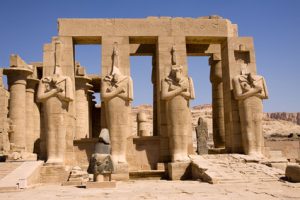
King Ramses II called his temple "The Temple of Millions of Years of User-Maat-Ra", which was one of his titles that means 'the Power of the Justice of Ra'. Work in the temple continued from the beginning of the reign of Ramses II until the 22nd year of his reign. But not long after the end of the New Kingdom, the Ramesseum was stripped of its wealth by hungry citizens; and its buildings were used as quarries for the construction of other monuments. Tombs for major and minor court officials were put into the bedrock beneath it; small shrines built from its stones; and a Christian church built within the ruins. Today, the entrance to the temple is a narrow doorway in the northeast corner of the enclosure wall. The huge First Pylon (now badly damaged) is 67 meters wide and originally about 24 meters high. Similar to the scenes of many other monuments of Ramses II, those of the Ramesseum depict the wars of the King against the Hittites.

The First Court of the Ramesseum On the south side of the First Court of the Memorial Temple of Ramses II (Ramesseum), one can eye the remains of a double row of columns, behind which stands a doorway that once led into the King's palace. Behind the palace, lie the remains of recently excavated kitchens, bakeries, and a slaughter-house for the priests and the royal family. On the west side of the court, are found the remains of the colossal statue of Ramses II. The original statue (the largest monolithic statue ever sculpted) is a granite monolith of 17.5 meters high without the base and its weight measured over one thousand tons. One ear measures more than one meter long and the shoulders are over 7 meters broad.
On the south side of the First Court of the Memorial Temple of Ramses II (Ramesseum), one can eye the remains of a double row of columns, behind which stands a doorway that once led into the King's palace. Behind the palace, lie the remains of recently excavated kitchens, bakeries, and a slaughter-house for the priests and the royal family. On the west side of the court, are found the remains of the colossal statue of Ramses II. The original statue (the largest monolithic statue ever sculpted) is a granite monolith of 17.5 meters high without the base and its weight measured over one thousand tons. One ear measures more than one meter long and the shoulders are over 7 meters broad.

The Second Pylon of the Ramesseum
The Second Pylon of the Ramesseum is in a very bad status and only part of its north tower remains to our times. The bedrock, on which the pylon was built, is two meters higher than the first court; and a staircase led to the pylon. Around the Second Court, one can find a portico with rows of Osiride pillars on the east and west sides and columns on the west, north and south ones. The face of the Second Pylon, behind the portico, is decorated with scenes of Ramses' military campaigns into Western Asia as well as scenes of the representation of the battle that vividly depicts a surviving image of the actual confusion and struggle between both the Hittite and the Egyptian armies. In the upper register of the same pylon, are pictured scenes portraying the harvest festivals for the god Min. Birds are depicted released into the air, each with a small piece of papyrus hanging around its neck to spread the good news of the king's coronation around the world.
The Second Court of the Ramesseum
The walls, columns, and pillars of the Second Court of the Ramesseum are largely destroyed. On the western side of the court, three staircases lead to a portico and a hypostyle hall. In front of the portico, one finds ten Osiride pillars and ten columns, behind which scenes of Ramses II worshipping Atum, Montu, Ptah, Amoun, Mut and Khonsu are gracefully depicted.


The Outbuildings of the Ramesseum
Around the main temple were erected the well-preserved mud-brick storerooms. In these buildings, tributes were paid by foreign countries; and agricultural surpluses were stored and redistributed. On the north side of the temple, we can also see the remains of the foundations of the small temple of Seti I, father of Ramses II. This chapel was converted in a Mammisi or (Birth House) in honor of Tuya (mother of Ramses II) and his wife (Nefertari). In Its courtyard we can find a colossal statue of Tuya.

